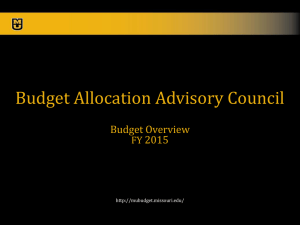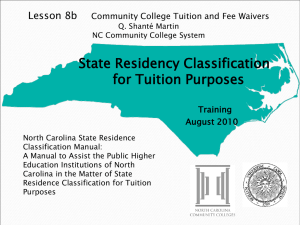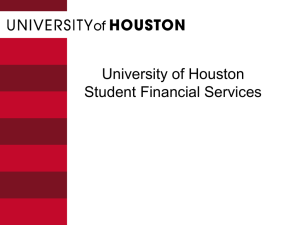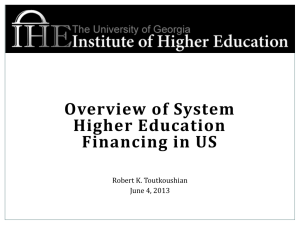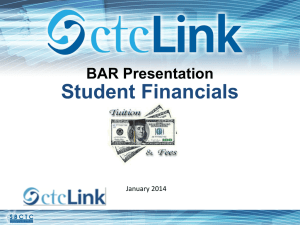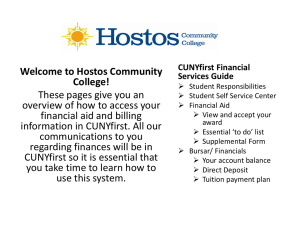Tuition Discounting Practices Breaking the Cycle
advertisement
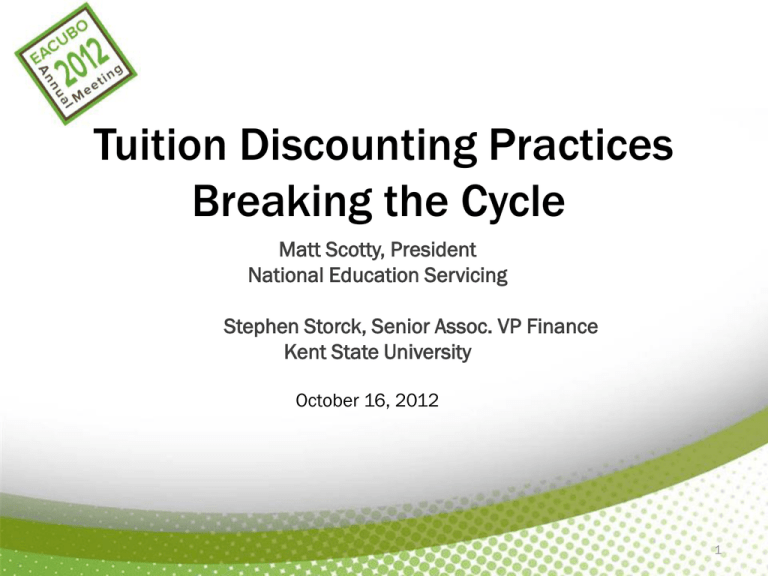
Tuition Discounting Practices Breaking the Cycle Matt Scotty, President National Education Servicing Stephen Storck, Senior Assoc. VP Finance Kent State University October 16, 2012 1 Vicious Cycle * • A complex series of events, with no tendency toward equilibrium, in which each iteration of the cycle reinforces the previous one. • The cycle continues in the direction of its momentum until an external factor intervenes and breaks the cycle. * As defined by Wikipedia 2 Vicious Cycle A complex series of events, with no tendency toward equilibrium…. School Increases Discount to Attract More Students School Sets Firm Price Enrollment Projection Falls Short 3 Vicious Cycle A complex series of events, with no tendency toward equilibrium…. School Sets Firm Price Student Appeals Discount Rate Increases School Reviews Appeal School offers more aid 4 What Does the Future Hold? • What will happen if the current cycle (trend) of rising tuition and discounts continues? 5 Discounts – Historical & Projected …in which each iteration of the cycle reinforces the previous one. $45,000 64.00% $40,000 56.00% $35,000 48.00% $30,000 40.00% $25,000 32.00% $20,000 24.00% $15,000 16.00% $10,000 Stated Tuition Net Tuition Discount 20 24 -2 5 20 22 -2 3 20 20 -2 1 20 18 -1 9 20 16 -1 7 20 14 -1 5 20 12 -1 3 20 10 -1 1 20 08 -0 9 20 06 -0 7 20 04 -0 5 20 02 -0 3 0.00% 20 00 -0 1 $0 19 98 -9 9 8.00% 19 96 -9 7 $5,000 6 Well-recognized Issue …the cycle continues in the direction of its momentum Many Industry Studies have highlighted the challenge: - The 2012 IHE Business Officer Survey indicates: - Over 81% of CFOs at private schools identified increasing net tuition revenue as an important strategy over the next 2-3 years - More than half of CFOs at private master’s institutions (54.7%) and baccalaureate colleges (56.2%) cited their discount rates as “unsustainable” - Some have tried to address the issue, but very few have done so successfully. 7 SOLUTION … until an external factor intervenes and breaks the cycle. One solution is a product we’ve designed – Hybrid between a loan and tuition payment plan – Schools recapture revenue they had been giving away as institutional aid. 8 What is… • An extended tuition payment plan • Financed by your institution • Managed in full by National Education 9 How did this come about? – Small CFO meeting a couple of years back – Focus Groups – Scores of direct conversations with private schools across the country 10 What are the advantages…. SAGE Tuition Advantage increases net tuition revenue by providing financing options instead of unfunded institutional aid. – Increase student retention and graduation – Manage discount rates – Recaptured Revenue can be used at school’s discretion 11 Program Features • • • • Up to 25% forgiveness Potential 0% APR Interest Free until repayment Manageable loan sizes 12 Sage Tuition Advantage Calculator SageTuitionAdvantage.com 13 Summary • Tuition Discounting is stuck in a vicious cycle • Small changes on the fringe will not break the cycle • Schools must use some external factor to break the cycle • One such external factor is SAGE Tuition Advantage. 14 Questions / Discussion How will you break the cycle? 15 Additional Resources • • • • • • • • • Blumenstyk, Goldie. “One-Third of Colleges Are on Financially 'Unsustainable' Path, Bain Study Finds.” Chronicle.com. 2012. July 23, 2012 < http://chronicle.com/article/One-Third-of-Colleges-Areon/133095/>. Denneen, Jeff & Dretler, Tom. “The financially sustainable university.” Bain.com. 2012. July 6, 2012< http://www.bain.com/publications/articles/financially-sustainable-university.aspx>. Green, Kenneth C. “The 2012 Inside Higher Ed Survey of College & University Business Officers.” Insidehighered.com. 2012. July 27, 2012 < http://www.insidehighered.com/news/survey>. Hoover, Eric. “Two-Fifths of Parents Expect Children to Cover All or Most College Costs.” Chronicle.com. 2012. July 23, 2012< http://chronicle.com/blogs/headcount/two-fifths-of-parents-expect-children-tocover-all-or-most-college-costs/30907>. Kiley, Kevin. “Short-Term Focus, Long-Term Problems: A Survey of Business Officers.” Insidehighered.com. 2012. July 27, 2012< http://www.insidehighered.com/news/survey/business_officer_2012>. Kiley, Kevin. “Cost of Free Money.” Insidehighered.com. 2012. August 30, 2012 < http://www.insidehighered.com/news/2012/08/30/long-island-university-overspending-financial-aidreflects-affordability-concern>. Kiley, Kevin. “Bigger Picture, Smaller Numbers.” Insidehighered.com. 2012. September 14, 2012 http://www.insidehighered.com/news/2012/09/14/saint-benedict-sees-revenue-grow-while-shrinkingenrollment>. Lederman, Doug. “Maintenance Over Management: A Survey of Business Officers.” Insidehighered.com. 2011. July 6, 2011< http://www.insidehighered.com/news/survey/business_officer_2011>. NACUBO. “2011Tuition Discounting Study Report.” NACUBO.org. April 2012. http://www.nacubo.org/Products/Online_Research_Products/2011_Tuition_Discounting_Study.html >. 16
